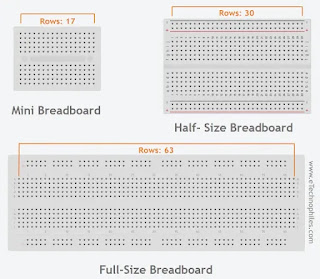Introduction
 |
| Modern Breadboard |
What is a Breadboard?
 |
| Early Day Breadboard |
A breadboard is a solderless device used for testing electronic circuits by making temporary connections.
 |
| Early Wire Wrapping Breadboard |
The term "breadboard" comes from the early days of electronics when people prototyped circuits on wooden breadboards. Modern breadboards were introduced in the 1970s by Ronald J Portugal and are rectangular with a grid of holes. These holes connect to metal strips underneath, enabling electrical connections between components.
Inside a Breadboard
 |
| Breadboard Inside Back View |
Terminal Strips: Vertical strips with five sockets that run parallel to each other. Inserting a component pin into one of these strips connects it internally to the whole strip, providing four additional connection points.
 |
| Breadboard Terminal Strip Inside View |
Power Rails: Horizontal strips, typically found on the sides, used to create positive and negative nodes for the circuit. These are often marked with red (+) and blue/black (-).
Center Divider: Divides the breadboard into two halves, providing support for DIP ICs.
Types of Breadboards
 |
| Breadboard Size Types |
Breadboards come in various sizes:
Full-size: typically has 840 holes.
Half-size: comes with 400 holes.
Mini: features 170 holes and lacks power rails.
 |
| Breadboard of Transparent Type |
They also come in different colors, including transparent ones. Some breadboards include binding posts to easily connect external power sources.
 |
| Breadboard With Binding Posts |
Prototyping: Breadboards facilitate easy prototyping of both simple and complex circuits.
Component Testing: They offer a quick way to check components before incorporating them into final projects.
Accessibility: Breadboards eliminate the need for complex CAD software for initial circuit testing.
Reusability: Solderless connections make breadboards reusable.
Labels and Markings
 |
| Breadboard Label & Marking View |
Full-size breadboards have columns labeled A to J and rows labeled 1 to 30 (or more). These labels help in tracking connections, especially in complex projects.
Conclusion
 |
| Breadboard Parts Front View |
Want to learn breadboarding without the hassle? The "TinkerCAD Circuits Reference Handbook" simplifies everything with a simulated experience! Buy it now and start building circuits virtually!
For more details on eBook click this link:
TinkerCAD Circuits Reference Handbook eBook: About Page
Happy Tinkering!
…till next post, bye-bye and take care.


No comments:
Post a Comment